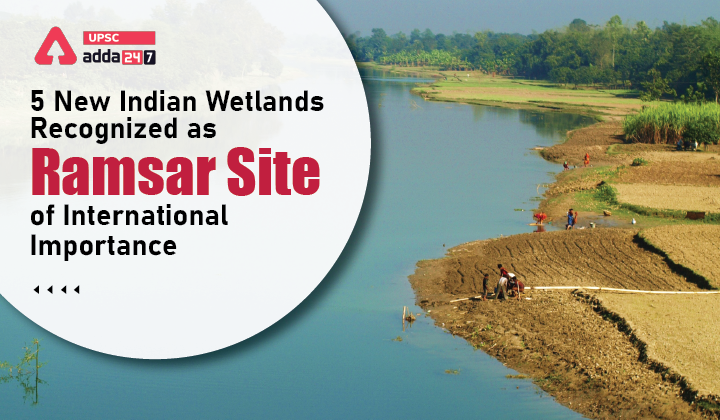Table of Contents
Indian Wetlands Recognized as Ramsar Sites- Relevance for UPSC Exam
- GS Paper 3: Environment- Conservation, environmental pollution and degradation.
Indian Wetlands Recognized as Ramsar Sites in News
- Recently, government informed that five new Indian sites have been recognised as wetlandsof international importance, as part of the Ramsar Convention.
List of Five New Wetlands designated as Ramsar Sites
- Total Ramsar Wetland in India: With recognition of five new Indian Wetlands as the Ramsar Sites of International Importance, India has now 54 Ramsar sites in the country from the previous 49.
- List of the New Ramsar Sites: The Newly Inducted wetland sites are from-
- Three wetlands from Tamil Nadu-
- Karikili Bird Sanctuary,
- Pallikaranai Marsh Reserve Forest and
- Pichavaram Mangrove).
- One in Mizoram-
- Pala wetland
- One in Madhya Pradesh-
- Sakhya Sagar
- Three wetlands from Tamil Nadu-
What is Ramsar recognition?
- Ramsar recognition is the identification of wetlands around the world, which are of international importance, especially if they provide habitat to waterfowl(about 180 species of birds).
- There is international interest and cooperation in the conservation of such wetlands and a judicious use of their resources.
About Ramsar convention
- The Ramsar Convention on Wetlands is the oldest of the modern global intergovernmental environmental agreements.
- The treaty was negotiated through the 1960s by countries and non – governmental organizations concerned about the increasing loss and degradation of wetland habitat for migratory waterbirds.
- It was adopted in the Iranian city of Ramsar in 1971 and came into force in 1975.
- Since then, the Convention on Wetlands has been known as the Ramsar Convention.
- The Contracting Parties approved the Fourth Strategic Plan for 2016-2024 at COP12.
- Ramsar Convention’s broad aims are to halt the worldwide loss of wetlands and to conserve, through wise use and management, those that remain.
What are wetlands?
- According to WWF, a wetland is a place where the land is covered by water, either salt, fresh or somewhere in between.
- Marshes and ponds, the edge of a lake or ocean, the delta at the mouth of a river, low-lying areas that frequently flood—all of these are wetlands.
Types of wetlands
Under the Ramsar convention, wetlands have been classified into following three categories:
- Marine/Coastal Wetlands: includes permanent shallow marine waters; coral reefs; estuarine waters; intertidal marshes, coastal lagoons, among others.
- Inland wetlands: includes Permanent inland deltas; Permanent rivers/streams/creeks; alpine wetlands, tundra wetlands; waterfalls; geothermal wetlands, among others.
- Human-made wetlands: aquaculture ponds; irrigated land; water storage areas; wastewater treatment areas; Canals and drainage channels, ditches; among others.
List of Ramsar Wetland Sites in India




 TSPSC Group 1 Question Paper 2024, Downl...
TSPSC Group 1 Question Paper 2024, Downl...
 TSPSC Group 1 Answer key 2024 Out, Downl...
TSPSC Group 1 Answer key 2024 Out, Downl...
 UPSC Prelims 2024 Question Paper, Downlo...
UPSC Prelims 2024 Question Paper, Downlo...





